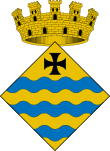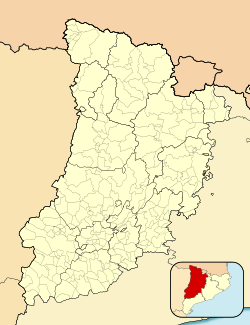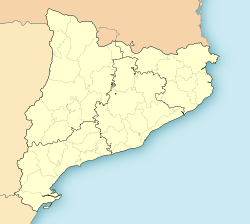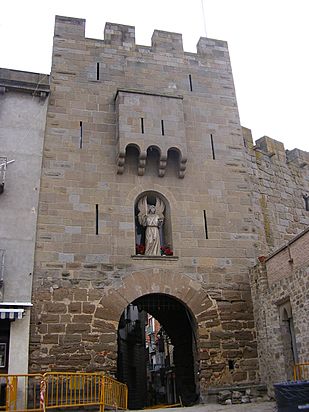Guissona facts for kids
Quick facts for kids
Guissona
|
|||
|---|---|---|---|
|
Municipality
|
|||

Guissona - Església de Santa Maria (Saint Mary's Church)
|
|||
|
|||
| Country | |||
| Autonomous community | |||
| Province | Lleida | ||
| Comarca | Segarra | ||
| Government | |||
| • Type | Mayor–council | ||
| Area | |||
| • Total | 18.1 km2 (7.0 sq mi) | ||
| Elevation | 485 m (1,591 ft) | ||
| Population
(2018)
|
|||
| • Total | 7,034 | ||
| • Density | 388.6/km2 (1,006.5/sq mi) | ||
| Demonym(s) | guissonenc/guissonenca | ||
| Postcode |
25210
|
||
Guissona is a lively town and municipality in Catalonia, Spain. It's located in the northern part of a region called Segarra, within the province of Lleida. In 2018, about 7,034 people lived there.
Guissona is the second most populated town in Segarra, after Cervera. The municipality also includes a smaller place called Guarda-si-venes. Most of Guissona's population lives in the larger eastern part of the town.
Over the last 50 years, Guissona has grown a lot. This growth is mainly thanks to its strong meat production and meat packing industry. As the economy grew, so did the number of people living there. The town has seen a big increase in its population, including many immigrants.
Contents
What Guissona's Economy is Like
Guissona's economy is mostly based on farming and the food processing industry. Farmers grow crops and raise animals.
A big company called Grup Alimentari Guissona is based here. It started as a group of farmers working together. Now, it's a large company that makes and sells food products in its own stores.
How Guissona's Population Has Changed
The table below shows how many people have lived in Guissona over many years, starting from 1497. You can see how the population has grown and changed over time.
| Historical population | ||||||||||||||||||||||||||||||||||||||||||||||||||||||||||||||||||||||||||||||||||||||||||||
|---|---|---|---|---|---|---|---|---|---|---|---|---|---|---|---|---|---|---|---|---|---|---|---|---|---|---|---|---|---|---|---|---|---|---|---|---|---|---|---|---|---|---|---|---|---|---|---|---|---|---|---|---|---|---|---|---|---|---|---|---|---|---|---|---|---|---|---|---|---|---|---|---|---|---|---|---|---|---|---|---|---|---|---|---|---|---|---|---|---|---|---|---|
|
|
|
||||||||||||||||||||||||||||||||||||||||||||||||||||||||||||||||||||||||||||||||||||||||||
Guissona's Long History
Guissona has a very old history, going back thousands of years!
Ancient Times: Iberians and Romans
The first known settlement was an Iberian town called Iesso. It was built around the 8th or 9th century BC, during the early Iron Age. This ancient town was located where the Plaça del Vell Pla is today.
The people of Iesso even made their own coins. These coins often showed a male head on one side and a horseman on the other. They were used from the late 2nd to early 1st century BC.
Later, the Romans took over Iesso and made it a Roman municipality. Famous Roman writers like Pliny the Elder and Ptolemy mentioned the town. The Romans built a strong defensive wall around the town, which was much larger than the old historic center.
Many Roman remains can still be found in Guissona. These include parts of Roman thermae (public baths) and old headstones. One famous gravestone belongs to Servilla Praepusa from the 2nd or 3rd century AD. There's also a sculpture of a Roman horseman and an ancient burial ground.
Medieval Times: Changes and New Buildings
Guissona might have been the home of a bishop (a church leader) a long time ago. But the bishop's seat later moved to La Seu d'Urgell after the Muslim invasion.
In 975 AD, the Christian leader Borrell II, Count of Barcelona took control of Guissona. However, the Caliphate of Córdoba (a Muslim empire) recaptured it in 1015. By 1024, Guissona was taken back by Christians, and Ermengol, the bishop of Urgell, helped bring Christianity back to the area.
In 1072, Count Ermengol IV of Urgell began building a Romanesque church. It was called Església de Santa Maria de Guissona (Church of Saint Mary of Guissona).
Centuries later, this old church was taken down to build a new one. The construction of the new church lasted through the 17th and 18th centuries. It finally opened in 1800. The finished church mixed different styles of Baroque and Neoclassical art. Sadly, during the Spanish Civil War, the church's organ and altars were destroyed.
Around 1505, work began on a building called Obra de Fluvià. This building was meant to be a home for the Bishop of Urgell. The construction stopped in 1514. Its ruins are about a kilometer away, near the Fluvià and Sió rivers. The remaining parts show a late Gothic style. The building was designed with a square shape and a central courtyard.
The church leaders also started an Augustinian monastery in Guissona. In the 15th century, this monastery became a regular church with a group of priests.
The Carlist War Battle
On June 12, 1837, a battle took place near Guissona during the First Carlist War. The Carlist army, led by the Infante Sebastian of Portugal and Spain, was defeated. They lost to the "Liberals," who were commanded by the Baron of Meer.
Famous People from Guissona
- Pedro Fages Beleta (1734–1794), also known as El Oso (The Bear), was a soldier and explorer. He was the second military Governor of California Nueva (which later became Alta California) from 1770 to 1774. He also served as governor of Las Californias from 1782 to 1791.
Places to Visit in Guissona
Guissona has many interesting historical sites to explore:
- Old Defensive Walls: You can still see parts of the Medieval defensive walls and one of the old gates.
- La Plaça Major: This is the main town square, surrounded by beautiful arcades.
- Església de Santa Maria: This is Saint Mary's Church, with its impressive Baroque and Neoclassical designs.
- Municipal Museum: This museum has a collection of interesting artifacts from the past. You can see ancient pottery, paintings, and sculptures.
- "Obra de Fluvià": These are the ruins of the unfinished Bishop's palace. It was built in the 16th century in a late Gothic style. You can find it on the edge of town.
-
Guissona - Obra de Fluvià, the unfinished Episcopal Palace from the 16th century.
See also
 In Spanish: Guisona para niños
In Spanish: Guisona para niños








